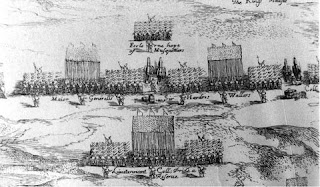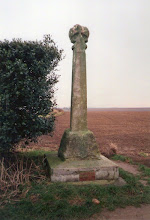I've had a Thirty Years War (TYW) project in 2mm on the 'back burner' for a long time. A very long time! As I have mentioned in a
previous post, there are some terrific 2mm gamers out there who I am 'leaning on' heavily for this project.
For instance, for the 2mm enthusiast I thoroughly recommend a wander around Sydney Roundwood's blog (
Roundwood's World) and check out his wonderful
Lützen (1632) and
Nördlingen (1634) projects in 2mm. I liked the result so much, I have shamelessly copied the winter basing Sydney has used.
After all, Imitation is the sincerest form of flattery that mediocrity can pay to greatness!
 |
| What I love about 2mm as a scale, one small bag contains a few weekends of work! |
 |
| Hmmmm. So, what to do with them... |
However, I have added my own mark to the project by indulging my interest in 17th century military theory when basing the 2mm blocks. Rather than limiting myself to the standard approach of pike with two wings of musket, I have sought to reproduce the various deployments outlined in tomes such as Richard Elton's The Complete Body of the Art Military (1650) and Collonel (
sic) William Bariffe's
Military Discipline, for the Young Artilleryman (1657).

While in many cases the deployments of foot troops discussed in these manuals tend towards the theoretical rather than actually reflecting those used in the field, it helped me better understand the texts and posed interesting challenges in working with the blocks and the space available on the base.
Overall, the main
Irregular Miniatures blocks I used for these bases were:
- RBG7, 45 figure 1-2 pike/shot unit (15 pike/30 shot);
- RBG12, 3-rank Forlorn Hope - 15 figures;
- RBG33, 15 figure Pike block;
- RBG25 Command - 2 figures;
- RBG9, Swiss/Landsknecht pike unit (40 pikes);
- BG2, Infantry in three ranks (24 figures) (these are from the Horse and Musket range; but make great musket units);
- Oh, and of course, the Tercio! - RBG10, Tercio (100 figures 40 pike/60 shot).
What rules, you ask? I have yet to track down a set of rules that I am totally happy with for either TYW or ACW gaming in 2mm. Nevertheless, for TYW, I have been considering
Polemos ECW, the 2 by 2 variants from the
2mm Yahoo Group, Jackson Gamers' English Civil War Rules '
Charge yr Pike! and the free older version of
Father Tilly (version 3).
My basing scheme is using a 50mm x 25mm bases (c. 2"x1") for foot and cavalry with each foot base being a regiment and each cavalry base a squadron. Command and artillery (and possibly detachments of shot) will be on 25 x 25mm (c. 1" x 1") bases. So, basically, a scaled down Polemos basing system.
 |
For larger regiments of foot I used the RBG9 pike block with wings of two blocks of BG2 for the musket. In come cases I used some RBG12 as musket either deployed forward as the Forlorn Hope or to the
rear as reserves. |
 |
When laying out the regiments I found it very useful to rule up the base to help with positioning the pike and musket blocks (RGB12 and RGB33 in this case). It gave them a nice, crisp military feel.
In this case, I'm laying out 'a squadron or third part of a Swedish Brigade' as described by Bariffe, in Military Discipline..., p. 172. |
 |
| All three squadrons deployed in the style of the Swedish Brigade. |
 |
| Rather than laying out some units in with their pike to the left or right (depending on their flank), and with musket in reserve at the rear, I based all of the three squadrons as laid out on p. 172 - assuming the commander would deploy as necessary! |
 |
| Bariffe goes on to describe a series of deployments for 'imbattelling larger numbers' (Military Discipline..., p. 130. In the next series of bases I have adopted various forms of the 'double Crosse-Battle.' In describing these forms of deploying regiments/squadrons of foot, Bariffe notes they '...may bring most hands to the fight, with conveniency, so that one part of your Battle doe not cumber or hinder the other...' (p. 130). |
 |
| In this second form, after the musketeers have '...fired once or twice over, the Front-division of Pikes may move forwards, porting, until they range-even with the front of the Musquettiers, and there charge their Pikes: The Musquettiers still continuing their Firing. The Reer divisions of Pikes, in the mean time facing to the right and left-outward, and sleeving-up the flanks of the Reer-division of Musquettiers; there in like manner charging their Pikes. either to the front or flanks...' (p. 132) |
Finally, below are a few pictures of my first attempts to pain some of the above bases. I have gone for fairly generic colour schemes. I have used the same approach as my ACW 2mm basing where I paint a discoloured patch to the rear of units to represent their footprints in the frost/snow.






















